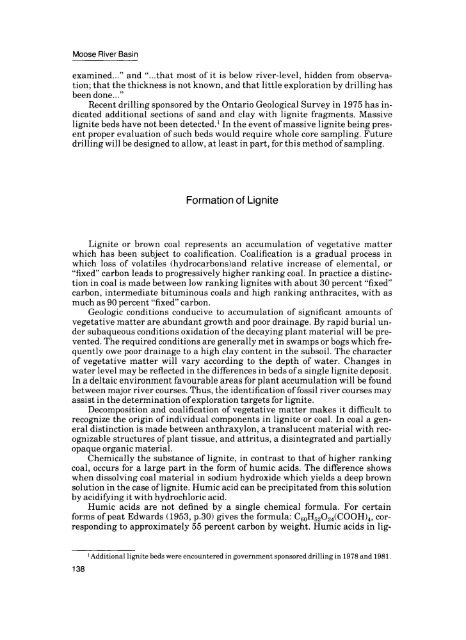Moose River Basin: geology and mineral potential - Geology Ontario
Moose River Basin: geology and mineral potential - Geology Ontario
Moose River Basin: geology and mineral potential - Geology Ontario
You also want an ePaper? Increase the reach of your titles
YUMPU automatically turns print PDFs into web optimized ePapers that Google loves.
<strong>Moose</strong> <strong>River</strong> <strong>Basin</strong><br />
examined..." <strong>and</strong> "...that most of it is below river-level, hidden from observa<br />
tion; that the thickness is not known, <strong>and</strong> that little exploration by drilling has<br />
been done..."<br />
Recent drilling sponsored by the <strong>Ontario</strong> Geological Survey in 1975 has in<br />
dicated additional sections of s<strong>and</strong> <strong>and</strong> clay with lignite fragments. Massive<br />
lignite beds have not been detected. 1 In the event of massive lignite being pres<br />
ent proper evaluation of such beds would require whole core sampling. Future<br />
drilling will be designed to allow, at least in part, for this method of sampling.<br />
Formation of Lignite<br />
Lignite or brown coal represents an accumulation of vegetative matter<br />
which has been subject to coalification. Coalification is a gradual process in<br />
which loss of volatiles (hydrocarbons)<strong>and</strong> relative increase of elemental, or<br />
"fixed" carbon leads to progressively higher ranking coal. In practice a distinc<br />
tion in coal is made between low ranking lignites with about 30 percent "fixed"<br />
carbon, intermediate bituminous coals <strong>and</strong> high ranking anthracites, with as<br />
much as 90 percent "fixed" carbon.<br />
Geologic conditions conducive to accumulation of significant amounts of<br />
vegetative matter are abundant growth <strong>and</strong> poor drainage. By rapid burial un<br />
der subaqueous conditions oxidation of the decaying plant material will be pre<br />
vented. The required conditions are generally met in swamps or bogs which fre<br />
quently owe poor drainage to a high clay content in the subsoil. The character<br />
of vegetative matter will vary according to the depth of water. Changes in<br />
water level may be reflected in the differences in beds of a single lignite deposit.<br />
In a deltaic environment favourable areas for plant accumulation will be found<br />
between major river courses. Thus, the identification of fossil river courses may<br />
assist in the determination of exploration targets for lignite.<br />
Decomposition <strong>and</strong> coalification of vegetative matter makes it difficult to<br />
recognize the origin of individual components in lignite or coal. In coal a gen<br />
eral distinction is made between anthraxylon, a translucent material with rec<br />
ognizable structures of plant tissue, <strong>and</strong> attritus, a disintegrated <strong>and</strong> partially<br />
opaque organic material.<br />
Chemically the substance of lignite, in contrast to that of higher ranking<br />
coal, occurs for a large part in the form of humic acids. The difference shows<br />
when dissolving coal material in sodium hydroxide which yields a deep brown<br />
solution in the case of lignite. Humic acid can be precipitated from this solution<br />
by acidifying it with hydrochloric acid.<br />
Humic acids are not defined by a single chemical formula. For certain<br />
forms of peat Edwards (1953, p.30) gives the formula: C 60H52O24(COOH)4, cor<br />
responding to approximately 55 percent carbon by weight. Humic acids in lig-<br />
138<br />
1 Additional lignite beds were encountered in government sponsored drilling in 1978 <strong>and</strong> 1981.

















